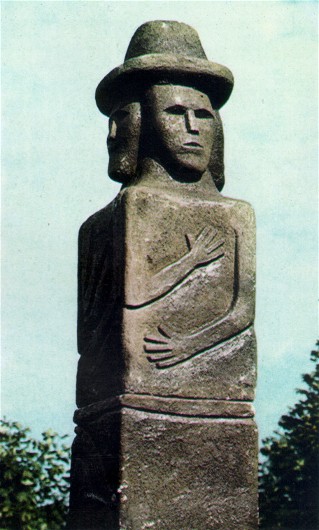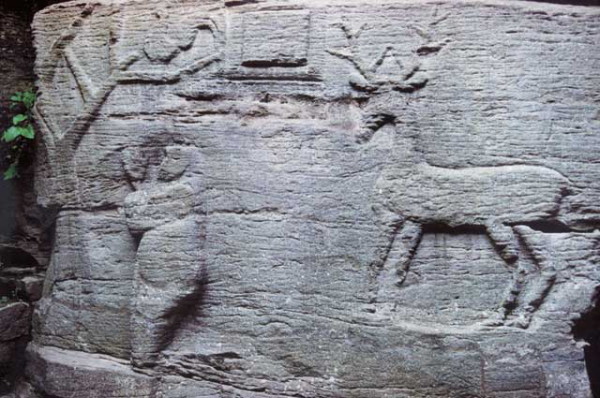Paganism
Paganism (from the Latin paganus ‘country dweller’; Ukrainian: pohanstvo). A general designation for pre-Christian polytheistic religions, the term came into common use in Europe after Constantine the Great adopted Christianity as the state religion of the Roman Empire in 313. In the medieval period even non-Christian monotheistic religions, such as Judaism and Islam, were considered pagan. The earliest reference to paganism in Ukraine appears in Procopius of Caesarea (6th century AD). Paganism survived long after the official Christianization of Ukraine in 988. Traces of it can be found even in the 20th century.
Paganism in Ukraine constantly evolved and changed. The oldest form was animism, which accepted the existence of good (berehyni) and evil (upyry, demony) spirits. Later, fertility gods (Rod and the rozhanytsi) and ancestral spirits were worshiped, and then a supreme deity, Svaroh, the god of heaven and fire. At the start of the rule of Volodymyr the Great the idols of the chief gods—Perun, Khors, Dazhboh, Stryboh, Symarhl, and Mokosh—stood on a hill near his palace. Plant, animal, and occasionally human sacrifices were brought before them. Upon adopting Christianity he destroyed the idols and built Saint Basil's Church at the site. Most of the common people continued to worship the pagan deities (see Mythology) and nature and household spirits (see Demonology).
The pagans did not build special shrines but worshiped in the open at altars on sacred sites. According to a Greek chronicler of the 10th century an altar was built under a great oak on Khortytsia Island, and Kyiv merchants sailing down the Dnipro River stopped to offer sacrifice there. Vikentii Khvoika excavated a site with a large sacrificial altar in Kyiv. Sacred sites of the first few centuries AD were found on vestal hills on the Dnipro River, near the village of Trypillia, and on the Ros River, near Sakhnivka (see Sakhnivka settlements). There were also several such sites on so-called Bald hills in Ukraine. In the Christian era these locales were believed to be the gathering places of witches and sorceresses. The pagans did not have a separate priestly caste, only soothsayers, known as volkhvy. Sacrifices on behalf of particular persons were brought by the persons themselves or their relatives; those for the benefit of a family, by the family head; and those for the country's sake, by the prince.
Pagans in Ukraine believed in the afterlife and viewed it as an extension of this life. According to foreign writers they preferred death to captivity out of the fear of remaining slaves after death. They were buried with their favorite objects and with symbols of their social status. The dead were usually buried, but some were cremated. Funerals involved various rituals and songs. (See Burial rites and Laments.) A year after a funeral a commemorative banquet was held. Weddings also were highly ritualized. Paganism tolerated polygamy, although most people, particularly the lower classes, practiced monogamy.
The Christian church actively opposed paganism. It supplanted the more popular cults with Christian ones: Perun with Saint Elijah, Veles with Saint George, Kupalo with Saint John the Baptist. The seasonal agricultural festivals were also modified and associated with Christian holidays: the winter equinox became Christmas, the ‘Great Day’ (Velykden’) became Easter, and the Rosalia became the Descent of the Holy Spirit. Each of these festivals retains to this day elements of pagan rites. Gradually the church introduced its sacraments into everyday life – first into baptism and burial, then, finally, into marriage. Some pagan folk customs (caroling, the blessing of wells and fields) that could not be suppressed were simply adopted by the church. The expected result, however, was not always achieved: in most cases, Christian and pagan rituals with the same function were practiced side by side. Other pagan customs, such as the harvest rituals, were converted from religious into folkloric practices. Soothsaying was incorporated into the games of Saint Andrew's Eve.
The people often interpreted church holidays in pagan terms; the Virgin Mary's Presentation at the Temple, for example, was viewed as a festival of the dead in Ukraine (the dead were said to ‘see’ their bodies on this day), and Christ's Presentation at the Temple celebrated the encounter between winter and spring.
Traces of paganism were preserved longest in various seasonal folk customs and rites, such as the Christmas Eve dinner, carols, the Easter vesnianky-hahilky, the transfer of livestock to the pasture in the springtime, the Kupalo festival, the harvest rituals, and pomynky (see Calendric ritual folk poetry). A number of pagan rites have been retained in the wedding ceremonies. The oldest forms of the Ukrainian folk oral literature, including tales, legends, and aphorisms, originated in the pagan era.
BIBLIOGRAPHY
Anichkov, E. Iazychestvo i drevniaia Rus’ (Saint Petersburg 1914)
Gal’kovskii, N. Bor’ba khristianstva s ostatkami iazychestva v drevnei Rusi, 2 vols (Kharkiv 1916)
Hrushevs’kyi, M. Z istoriï relihiinoï dumky na Ukraïni (Lviv 1925; 2nd edn, Munich 1962)
Rybakov, B. Iazychestvo drevnikh slavian (Kyiv 1981)
— Iazychestvo drevnei Rusi (Moscow 1987)
Mykola Mushynka
.jpg)

.jpg)

.jpg)